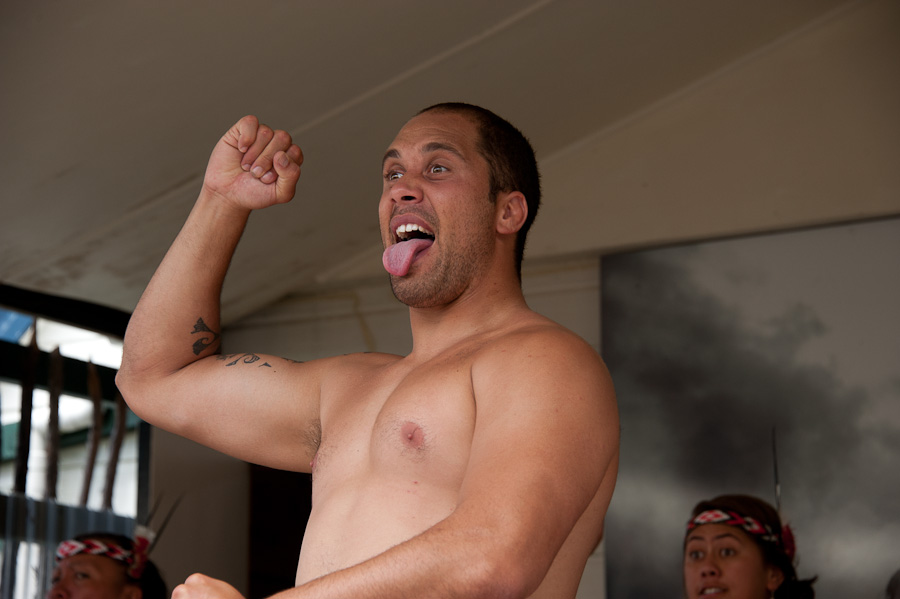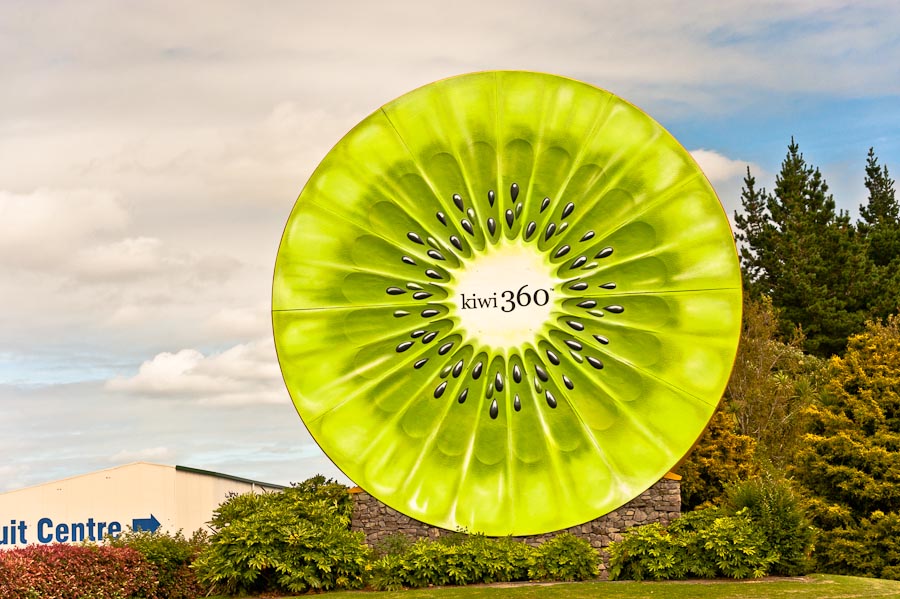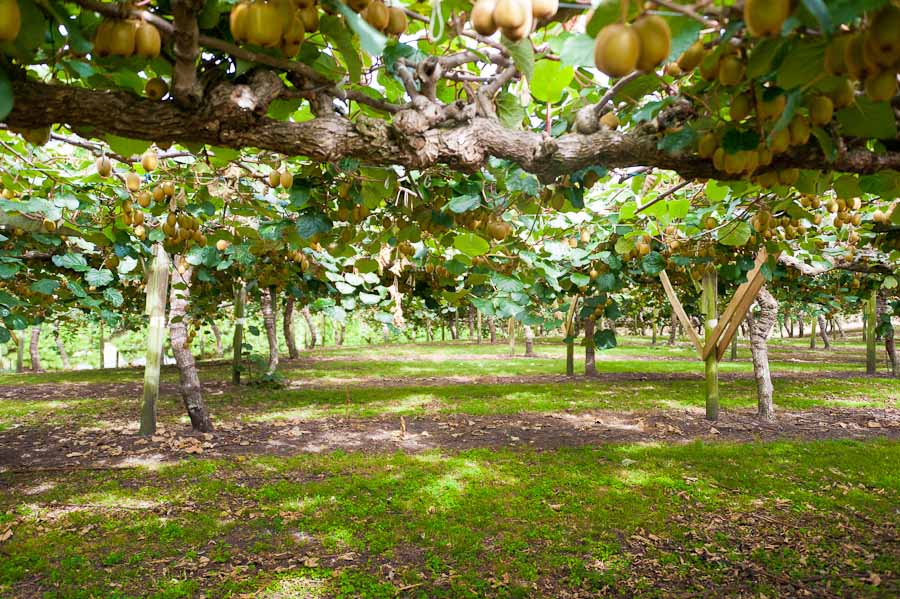Unfortunately, there was a loud knocking noise that happened multiple times last night that woke me repeatedly. Not fun. Dale got up to check it out around 4:00 am and went up to the pool deck, immediately on top of our suite, to see if he could figure it out. He found a worker and together they determined the noise must have been coming from a locked closet where they stored housekeeping supplies. Of course there wasn’t anyone around who had the key which meant my sleepless night continued.
Click here for the detailed Tauranga Photo Gallery.
We opted to go Independent today, so Dale got up early to go find out what was available. He walked to the iSite tour building just outside the dock area and compared renting a car with taking a comprehensive van-based tour and opted for the tour of Rotorua, a lake-laced area about an hour from the port. With our tour tickets in hand, we made our way to the waiting mini van, where we were joined by two other couples from the Regatta and before long we were whisked off toward the first of our many stops.
Kiwi fruit is a major export of New Zealand and the Kiwi 360 farm was our first destination. The plants look a lot like large grapevines and the kiwi hang like bundles of large fuzzy grapes under the vines that wind around and bridge together to form a five foot high canopy that protects the fruit. They also had a nice, modern retail store with all kinds of kiwi related products, including jams, jellies, wines and liquors. We tasted some of those as well as the green kiwi, that we are familiar with, as well as gold kiwi and kiwi berries. The gold kiwi were a bit sweeter and less acidic and the berries were quite tart! We also learned about the special kinds of honey made here that have healing properties and are made into all types of creams, lotions and even used to impregnate bandages used in war zones.
We then drove past dense forest of pine trees that were purposely planted for harvesting lumber. They are carefully placed and thinned to be sustainable and an important export for NZ. Next stop was at a waterfall on the main river…the same river that the original Maori settlers used on their arrival. It is now popular with river rafters although none came down the waterfall while we were there.
Next was the highlight of the day where we got a very thorough tour of a village of the indigenous Maori people of New Zealand. The name of the village is Tewhakarewarewatangaoteopetauaawahiao, and yes, they made us pronounced it – which wasn’t easy! Check it out below:
The arrival of the Maori people to New Zealand is something of a mystery. It is estimated that the first Polynesians arrived over 1,000 years ago, possibly around 800 AD. Linguistic and cultural evidence suggests that the Maori travelled originally from the Cook Islands – an enormous feat at that time considering the prevailing winds make sailing in a southeast direction almost impossible. It is because of this that the first navigators probably came here by design, looking for land whose presence may have been indicated by migratory birds.
The village is set amidst a landscape of erupting geothermal activity, hot thermal springs and hot bubbling mud pools. There are twenty-five Maori families who live there and work either in the village or in the nearby area. We had a great tour by a local guide and got to see their lifestyle, living amongst the steam and sulfur which is constantly emitted from the surrounding hot springs, geysers and mud pools. Communal, thermal-powered ovens are used by the locals to cook their food and hot pools are used to “boil” items like corn. They are so efficient that it eliminates the need to have any stove in their homes! They also use communal pools to take their baths every day…no showers or bathtubs in their homes.
They also put on a cultural show that included an overview of the welcome celebration and a vocal history (through song) of their cultural. It was well done and we took some videos that we will post soon. One of the strange things about their welcome dance is they bulge their eyeballs and stick out their tongue to threaten their guests to see if they are friend or foe. Once they see you are friendly they welcome you into their village and the show stops. We were taken in as friends.
Our guide, Mike, took us to some local mud pools that were very nice – boiling and bubbling. Allegedly, the mud has some healing properties and they sell mud face masks, body cream, etc. all around in the area.
After the 75 minute ride back to the port, Dale and I opted to go find Internet and low and behold, Rotorua has free wireless Internet in the whole area! This place was definitely the highlight of our South Pacific Internet scavenger hunt! Unfortunately, we had to get to the ship before they left so we couldn’t take advantage of it.
It was a great day and we enjoyed the beauty of the downtown on our brief walk-about there as much as the tour to the countryside. Downtown is very clean and modern. It is sort of like the “Hyannis Port” of the North Island of Auckland. It is a beautiful seaside resort town with lots of energy, expensive real estate (beachfront $2 million+) and a plethora of water and beach-based activities like surfing and rowing competitions.
Back on the ship, I began the tedious process of packing our things as we get ready to disembark in Auckland tomorrow. Look out Regent, here we come!
Photography Comments:
Tauranga is a really interesting area with a wide variety of activities, terrain and people. Spending a couple weeks here would present many good photo opportunities. Even in one day we were presented with some nice shots. One of the challenges of the thermal village was that there was steam almost everywhere. Keeping your lens from fogging up was a real project! I took the D7000 with the 28-300. I should have brought my little add-on flash for the stage show but I managed to just set the camera to ISO 1600 to allow me to freeze the action, something that the flash would have done. The problem with the built-in flash with the zoom is when it is extended it shadows the flash, leaving a dark area along the bottom of the picture. Later on in the show I switched to the 35 lens which allowed me to use the flash.



.jpg)



Astrid Glander - ….did you ever find out what was in the closet???